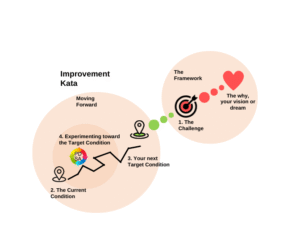
Make your performance meetings short, sharp, and action-oriented. Connect performance to strategy in an Obeya, pick the right leading/lagging indicators, work with PDSA, and go to gemba to test assumptions. Fewer opinions, more fact-based decisions—and visible results.
1. Introduction: connecting performance to strategy
Many leadership teams struggle with focusing on the performance of their organizational system and ensuring their performance meetings lead to meaningful discussions and actions. Often, the conversation is not driven by indicators or even observations, but feelings. This usually happens when there’s too little data to base decisions on.
This article helps you reconnect with the purpose of the performance of your organizational system and, more importantly, how to make leadership conversations about performance valuable.
In Leading with Obeya (LWO), the Performance area is an integral part of strategic execution. It connects directly to strategic direction, ensuring that performance is continuously evaluated in the context of what truly matters for the organization. Indicators used in this area are not about perfect measurement but should provide indications that help guide decisions and actions. These indications can be based on various types of input—both quantitative and qualitative.
A strong connection between strategic direction and performance ensures a feedback loop between plans, execution, and the value created. The performance meeting is where this loop is actively maintained, ensuring that insights from performance drive action, and the results of those actions are followed up to improve future performance.
The performance area – connecting strategy and execution
In Leading with Obeya, the performance area plays a crucial role in aligning execution with strategic direction. It is not just a space to track numbers—it provides the connection between where we want to go and what is happening in reality.
A strong performance area ensures that:
- Strategic direction drives performance discussions – Teams focus on what truly matters for long-term success through the connection with the strategic capabilities.
- Performance insights lead to action – Instead of passive reporting, teams actively adjust based on what they learn from the performance.
- A continuous learning cycle is in place – The performance indications are reviewed to learn from results of the plan and adapt for future
- Both leading (condition) and lagging (result) indicators are used – Ensuring that teams steer proactively on leading indicators and are able to assess the results of the impact (lagging indicators) effectively.
By creating a clear and structured performance area, leadership teams make better decisions, learn faster, and continuously improve their effectiveness. Important to note is that whatever conclusions there are, the leadership team must ensure they check any assumptions by going to gemba, the real place of work.
2. What makes a good performance meeting?
A useful performance meeting is not just about reviewing numbers but a structured leadership discussion focusing on what truly matters. A well-structured performance meeting should:
- Focus on what truly matters – Discussions around indicators are connected to strategic capabilities.
- Prioritize using results (lagging) indicators – The results help understand the impact of previous milestones and improvements, as input for prioritization of future milestones and improvements.
- Steer using condition (leading) indicators – Defining condition indicators and steering on them leads to influencing the results, and can be adapted accordingly.
- Ensure ownership – People feel responsible for the shared performance and act together on what it reveals.
- Follow a continuous improvement cycle – Regular reflection ensures the indicators and the performance itself improve over time.
With these principles in place, a performance meeting becomes a powerful leadership tool instead of a passive reporting exercise.
3. What is an indicator?
Indicators serve a crucial role in understanding performance. They are not meant to be perfect measurements but rather tools that provide meaningful indications to support leadership discussions and decision-making. A good indicator:
- Provide an indication or insight into how a system or process is behaving.
- Are measurable or observable but not always in numbers.
- Are tools for studying, learning, and improving, not just reporting.
- Make performance visible so teams can act on it.
- Help track progress toward strategic goals and guide decision-making.
Using indicators effectively
Indicators are not the goal themselves. Their role is to support a leadership conversation, improve decision-making, and lead to useful actions. The performance area helps teams:
- Monitor progress – Understand whether actions are leading to results.
- Improve decision-making – Use insights to act with confidence.
- Increase transparency and accountability – Ensure teams have a shared view of performance.
- Set priorities and allocate resources effectively – based on the actual performance.
- Drive continuous improvement – use the performance to assess results and learnings from actions, and follow-up on performance observations to keep improving.
4. The challenge of too little data (and what to do about it)
Many organizations face the challenge of too little data. While some aspects of performance are easy to measure, others are less tangible. However, just because something is difficult to measure doesn’t mean it should be ignored. The key is to develop a pragmatic approach to generating useful indications that help guide decision-making and action. I have seen too many leadership teams work hard to get all the numbers right, without having the impactful conversations that could have happened already.
What if something isn’t measurable?
Many crucial aspects of leadership and performance are hard to measure—things like team dynamics, innovation, or customer experience. However, just because something is
difficult to measure doesn’t mean it’s not important. Instead of dismissing these elements, teams should ask:
- How can we observe or sense this or make it visible?
- What indications already exist that help us understand it?
- How can we study and learn from it over time?
Indicators in Obeya should go beyond numbers to include qualitative observations, structured discussions, and feedback loops. The goal is not to create an illusion of precision but to gain useful insights that drive action.
Define what you need to know
First agree on what indicators are important based on your strategic capabilities, instead of starting with available data. This leads already to a shared understanding and a decision about priorities. Many teams start with the data they already have, while there might be data that they need but don’t have. You may identify gaps, but that’s okay. The purpose is to align indicators with strategic direction, ensuring they provide useful guidance.
Once you’ve defined the necessary indicators, take practical steps to collect indications, even if data is incomplete. The focus is not just on decisions but also on taking useful actions. Some ways to generate valuable indications include:
- ‘Plan’ which indicators you want to work on first, and realistically accept which you cannot have good indicators for initially.
- Using qualitative insights such as employee surveys, audit reports, and periodic deep-dive analyses. These can serve as conversation starters and lead to meaningful action.
- Gather simple indications, such as quick surveys (e.g., three questions via Mentimeter at an employee gathering), go to gemba and talk with people based on an observation, or structured observations.
- When it’s hard to gather the indicator (at that moment), place a simple question in the performance area of the Obeya, such as: How are we performing on <the indicator>? What do we learn from this? What do we need to explore further to adjust course? This stimulates a discussion, even when there is no good indicator (yet).
- Embedding performance questions into the routine per strategic capability, ensuring strategic capabilities are consistently evaluated (e.g., three standard questions per capability). The representative(s) of the strategic capability can place the answer to these questions in advance of the performance meeting in the Obeya.
Iterate and refine based on insights
If indicators are not available (yet), the pitfall is to try to get a perfect indicator straight away. An observation we have is that teams too often try to automate indicators too early, which wastes time and locks in assumptions before understanding what is truly needed.
Instead:
- Discover – Learn what you need to know. Place the first results on the Obeya, talk about it and learn whether it makes sense and what could be a next step to get more meaningful insights. This could also be part of the data (e.g. from process x, but not from process y yet), which already gives a first useful indication.
- Optimize – Refine the indicator based on what you’ve learned, ensuring it helps inmaking decisions and defining actions.
- Automate – Only after an indicator has proven valuable, you know how to visualize it, then start automating data collection. Automation is an effort, and adjusting the indicator is often hard, so only do this when it has proven its usefulness.
5. Conclusions and some other practical tips for making your performance meeting more impactful
- Start simple and realistic – Don’t aim for perfection, but for useful
- Choose indicators that add the most value – Accept that some indicators are worth putting effort in.
- Include qualitative observations – If needed, define actions to gather meaningful qualitative insights, like an analysis on a certain aspect.
- Use and discuss indicators that are not perfect yet in performance meetings to learn from actually looking at them – Ask: Do the indicators help in understanding performance? Do they support decision-making and action-taking?
- Follow the discover-optimize-automate cycle – Avoid premature automation
- For indicators that are hard to get, use the improvement pattern: Understand the challenge (of the indicator), assess the current situation, define a next realistic target situation (which is not perfection), and experiment towards that target to learn what kind of indicator is truly needed.
- Make performance meetings are about learning and adapting—not just
A great leadership team doesn’t adjust their performance by just tracking numbers or discuss feelings—they see, learn, and act together. By using indicators as a tool for decision-making, teams ensure they stay connected to strategic goals and continuously improve their perfomance
About the author
This article was written by Mark Uijen de Klein. He works as a Coach and Trainer at a Recognized Training Partner of Leading with Obeya: Obeya Coaching & Training from the Netherlands.
If you want to know more about possible partnerships, read more about it on our Partner page.
Source cited:
- Leading with Obeya, Tim Wiegel




